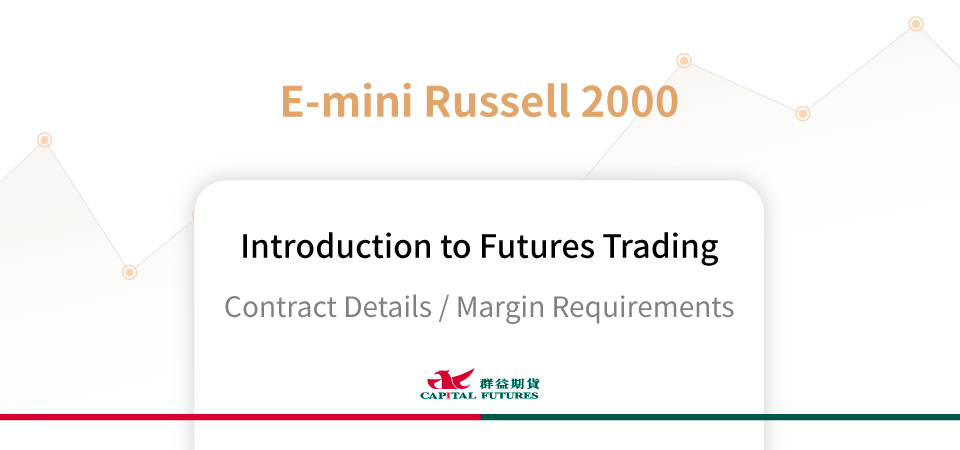E-mini Russell 2000 Futures Margin & Contract Specifications

What is the Russell 2000 Index?
The Russell 2000 Index is a key benchmark that reflects the performance of U.S. small-cap stocks. It includes around 2,000 publicly listed companies ranked between 1,001 and 3,000 by market capitalization, and is often regarded as a critical barometer for U.S. domestic demand and small business momentum.
E-mini Russell 2000 Futures
Launched by the Chicago Mercantile Exchange (CME), this is a smaller-scale version of the standard contract.
Micro E-mini Russell 2000 Futures
At one-tenth the size of the E-mini, it is designed for traders with limited capital and stricter risk management needs.
Both contracts are dollar-denominated, trade nearly 24 hours a day, and are characterized by high liquidity and trading flexibility.
Factors Influencing E-mini Russell 2000 Futures
1. U.S. Economic Growth and Domestic Demand
Most Russell 2000 companies are domestically oriented, with revenues heavily dependent on the U.S. economy.
When employment data is strong and consumer spending rises, the Russell 2000 typically outperforms large-cap stocks.
Example: Stronger-than-expected U.S. retail sales can lift the Russell 2000.
2. Interest Rates and Monetary Policy
Small-cap stocks are highly sensitive to borrowing costs.
Fed rate hikes → Higher financing costs, weaker earnings expectations, potential stock declines.
Fed rate cuts → Typically favorable for small and mid-sized companies, boosting the Russell 2000.
3. Inflation Data and Expectations
High inflation may squeeze profit margins for small businesses, especially those with limited pricing power.
Rising inflation expectations may also drive investors toward safe-haven assets, dragging down small-cap performance.
4. U.S. Dollar Strength
A stronger dollar can weaken U.S. exports, though its impact on the Russell 2000 is indirect.
Since its constituents rely primarily on domestic demand, a weaker dollar generally improves competitiveness for small-cap firms.
5. Rotation Between Large-Cap Tech and Small Caps
Market capital often rotates between large-cap and small-cap stocks.
When concerns about tech bubbles grow, capital may shift into cheaper small caps, lifting the Russell 2000.
Conversely, when funds concentrate heavily in mega-cap stocks (e.g., FAANG), the Russell 2000 may underperform.
6. Investor Sentiment and Risk Appetite
The Russell 2000 is often viewed as a proxy for market risk appetite.
In bullish, high-risk environments, small caps attract more investor interest.
In risk-off periods, capital tends to flow into blue chips or bonds, pressuring the Russell 2000.
7. ETF Flows and Index Fund Activity
The iShares Russell 2000 ETF (Ticker: IWM) is the primary ETF tracking the index.
Large inflows and outflows in IWM can amplify volatility in the index futures market.
8. Policy and Election Cycles
Policy changes such as tax reform or deregulation can significantly impact small businesses.
During U.S. presidential election years, heightened policy uncertainty often increases Russell 2000 volatility.
Both the E-mini Russell 2000 Futures and Micro E-mini contracts serve as excellent tools for tracking and trading the U.S. small-cap sector.
The E-mini suits traders with larger capital.
The Micro E-mini offers lower leverage and greater flexibility for position management.
In today’s volatile market, where sector rotation and style shifts occur frequently, Russell 2000 products are not only an alternative to crowded large-cap trades but also an effective way to gauge risk appetite and capture U.S. domestic demand momentum.
Whether your goal is short-term trading, exploring small-cap growth potential, or hedging against S&P/Nasdaq exposure, these products are valuable instruments to include in your strategy.
E-mini Russell 2000 Index Margin
How much money is needed to trade futures? At the beginning, the required margin is the initial margin. While holding a position, the margin after deducting floating profits and losses must remain above the maintenance margin; otherwise, a margin call will be issued. For day-trading margin, only half of the margin is required, provided the position is closed before the market closes.
Foreign Futures
| Name | Code | Initial Margin | Approximate Cost in TWD | Maintenance Margin | Day Trading Margin |
|---|---|---|---|---|---|
| E-mini Russell 2000 Index | RTY | USD 10,128 | 308,296 | USD 9,207 | USD 5,064 |
| Micro E-mini Russell 2000 Idx | M2K | USD 1,014 | 30,866 | USD 921 | USD 507 |
E-mini Russell 2000 Index Contract Specifications
Here is a summary for traders of the contract specifications, exchange, trading hours, minimum price fluctuation, and available trading months for E-mini Russell 2000 IndexFutures, Micro E-mini Russell 2000 IdxFutures.
| Name/Code | $ E-mini Russell 2000 IndexRTY |
|---|---|
| Exchange | Chicago Mercantile Exchange |
| Category | Futures |
| Local Trading Hours |
06:00-05:00 |
| Contract Specifications | Index×50 USD |
| Minimum Price Fluctuation | 0.1 point = 5 USD |
| Trading Months | 3,6,9,12 |
| Name/Code | $ Micro E-mini Russell 2000 IdxM2K |
|---|---|
| Exchange | Chicago Mercantile Exchange |
| Category | Futures |
| Local Trading Hours |
06:00-05:00 |
| Contract Specifications | Index×5 USD |
| Minimum Price Fluctuation | 0.1 Point=0.5 USD |
| Trading Months | 3,6,9,12 |
E-mini Russell 2000 IndexLast Trading Day
Futures
| Commodity | Jan | Feb | Mar | Apr | May | Jun | Jul | Aug | Sep | Oct | Nov | Dec | |
|---|---|---|---|---|---|---|---|---|---|---|---|---|---|
| E-mini Russell 2000 Index (RTY) | First Notice Day | - | - | 03/21 | - | - | 06/20 | - | - | 09/19 | - | - | 12/19 |
| Last Trading Day | - | - | 03/21 | - | - | 06/20 | - | - | 09/19 | - | - | 12/19 | |
| Micro E-mini Russell 2000 Idx (M2K) | First Notice Day | - | - | 03/21 | - | - | 06/20 | - | - | 09/19 | - | - | 12/19 |
| Last Trading Day | - | - | 03/21 | - | - | 06/20 | - | - | 09/19 | - | - | 12/19 | |




